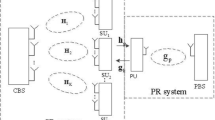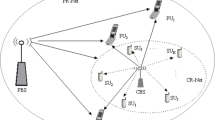Abstract
This paper investigates the sum rate capacity of MIMO broadcast channels (MIMO-BCs) in cognitive radio networks. A suboptimal user-selection algorithm is proposed to achieve a large sum rate capacity with reduced complexity. This algorithm consists of two steps. First, zero-forcing beamforming is utilized as a downlink precoding technique that precancels inter-user interference. Second, singular value decomposition is applied to the channel matrices of all the secondary users and only consider the singular vectors corresponding to the maximum singular values. The proposed user-selection algorithm chooses singular vectors which are nearly orthogonal to each other and nearly orthogonal to the vector of primary users. With this algorithm, the sum rate capacity of MIMO-BCs in CR networks with interference power constraints and transmit power constraints is derived. We formulate the sum rate capacity as a multi-constraint optimization problem and develop an algorithm to solve the problem in its equivalent form. Finally, numerical simulations are conducted to corroborate our theoretical results in flat Rayleigh fading environments. It is shown that the proposed algorithms are capable of achieving a large sum rate capacity with a very low complexity.
Similar content being viewed by others
References
Haddad M., Hayar A., Debbah M. (2008) Spectral efficiency of spectrum-pooling systems. IET Communications 2: 733–741
Hamdi K., Zhang W., Letaief K. (2009) Opportunistic spectrum sharing in cognitive MIMO wireless networks. IEEE Transactions on Wireless Communications 8: 4098–4109
Yu R., Zhang Y., Huang M., Xie S. (2010) Cross-layer optimized call admission control in cognitive radio networks. ACM/Springer Mobile Networks and Applications 15: 610–626
Bao X., Martins P., Song T., Shen L. (2011) Stable throughput and delay performance in cognitive cooperative systems. IET Communications 2: 190–198
Hoang A., Liang Y. C., Zeng Y. H. (2010) Adaptive joint scheduling of spectrum sensing and data transmission in cognitive radio networks. IEEE Transactions on Communications 58: 235–246
Choi K. W. (2010) Adaptive sensing technique to maximize spectrum utilization in cognitive radio. IEEE Transactions on Vehicular Technology 59: 992–998
Kang X., Liang Y. C., Nallanathanm A., Garg H. K., Zhang R. (2009) Optimal power allocation for fading channels in cognitive radio networks: Ergodic capacity and outage capacity. IEEE Transactions on Wireless Communications 8: 940–950
Wang C.-X., Hong X., Chen H.-H., Thompson J. (2009) On capacity of cognitive radio networks with average interference power constraints. IEEE Transactions on Wireless Communications 8: 1620–1625
Ma Y., Kim D. I., Wu Z. (2010) Optimization of OFDMA-based cellular cognitive radio networks. IEEE Transactions on Wireless Communications 58: 2265–2276
Jorswieck E. A., Boche H. (2007) Delay-limited capacity: Multiple antennas, moment constraints, and fading statistics. IEEE Transactions on Wireless Communications 6: 4204–4208
Foschini G. J., Gans M. J (1998) On limits of wireless communications in a fading environment when using multiple antennas. Wireless Personal Communications 6: 311–317
Lee S. H., Thompson J. (2010) Trade-off of multiplexing streams in MIMO broadcast channels. IEEE Communications Letters 14: 115–117
Gomadam K. S., Jafar S. A. (2010) Duality of MIMO multiple access channel and broadcast channel with amplify-and-forward relays. IEEE Transactions on Communications 58: 211–217
Udupa P. S., Lehner J. S. (2007) Optimizing zero-forcing precoders for MIMO broadcast systems. IEEE Transactions on Communications 55: 1516–1524
Feick R., Derpich M. S., Valuenzuela R. A., Carrasco H., Ahumada L., Huang H., Ng C. T. K., Arancibia P. (2011) An Empirical Study of the Achievable Rates of Several Indoor Network-MIMO Techniques. IEEE Transactions on Wireless Communications 10: 581–591
Lu P., Yang H. C. (2010) Sum-rate analysis of multiuser MIMO system with zero-forcing transmit beamforming. IEEE Transactions on Communications 57: 2585–2589
Zhang L., Liang Y.-C., Xin Y. (2008) Joint beamforming and power allocation for multiple access channels in cognitive radio networks. IEEE Journal of Selected Areas Communications 26: 38–51
Liang X. B. (2008) An algebraic, analytic, and algorithmic investigation on the capacity and capacity-achieving input probability distributions of finite-input finite-output discrete memoryless channels. IEEE Transactions on Information Theory 54: 1003–1023
Bayesteh A., Khandani A. K. (2010) On the user selection for MIMO broadcast channels. IEEE Transactions on Information Theory 54: 1086–1107
Author information
Authors and Affiliations
Corresponding author
Additional information
The work of H.-L. Xiao and S. Ouyang is supported by the National Basic Research Program of China “973” (Grant No.: 2008CB317109), Guangxi Natural Science Foundation (No.: 2011GXNSFD018028 and 0991241), NSFC (Grant No. 60972084). H.-L. Xiao and C.-X. Wang acknowledge the support from the Scottish Funding Council for the Joint Research Institute in Signal and Image Processing with the University of Edinburgh, as part of the Edinburgh Research Partnership in Engineering and Mathematics (ERPem), and the support from the RCUK for the UK-China Science Bridges: R\&D on (B) 4G Wireless Mobile Communications.
Rights and permissions
About this article
Cite this article
Xiao, HL., Ouyang, S. & Wang, CX. On the Sum Rate Capacity of MIMO Broadcast Channels in Cognitive Radio Networks with Interference Power Constraints. Wireless Pers Commun 70, 1589–1601 (2013). https://doi.org/10.1007/s11277-012-0767-3
Published:
Issue Date:
DOI: https://doi.org/10.1007/s11277-012-0767-3




